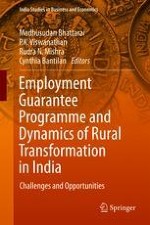2018 | OriginalPaper | Chapter
10. Inter-sectoral Linkages and Multipliers of MGNREGA in a Rainfed Village in Karnataka: Applications of Social Accounting Matrix (SAM)
Authors : Gourav Kumar Vani, P. S. Srikantha Murthy, Madhusudan Bhattarai
Published in: Employment Guarantee Programme and Dynamics of Rural Transformation in India
Publisher: Springer Singapore
Activate our intelligent search to find suitable subject content or patents.
Select sections of text to find matching patents with Artificial Intelligence. powered by
Select sections of text to find additional relevant content using AI-assisted search. powered by
